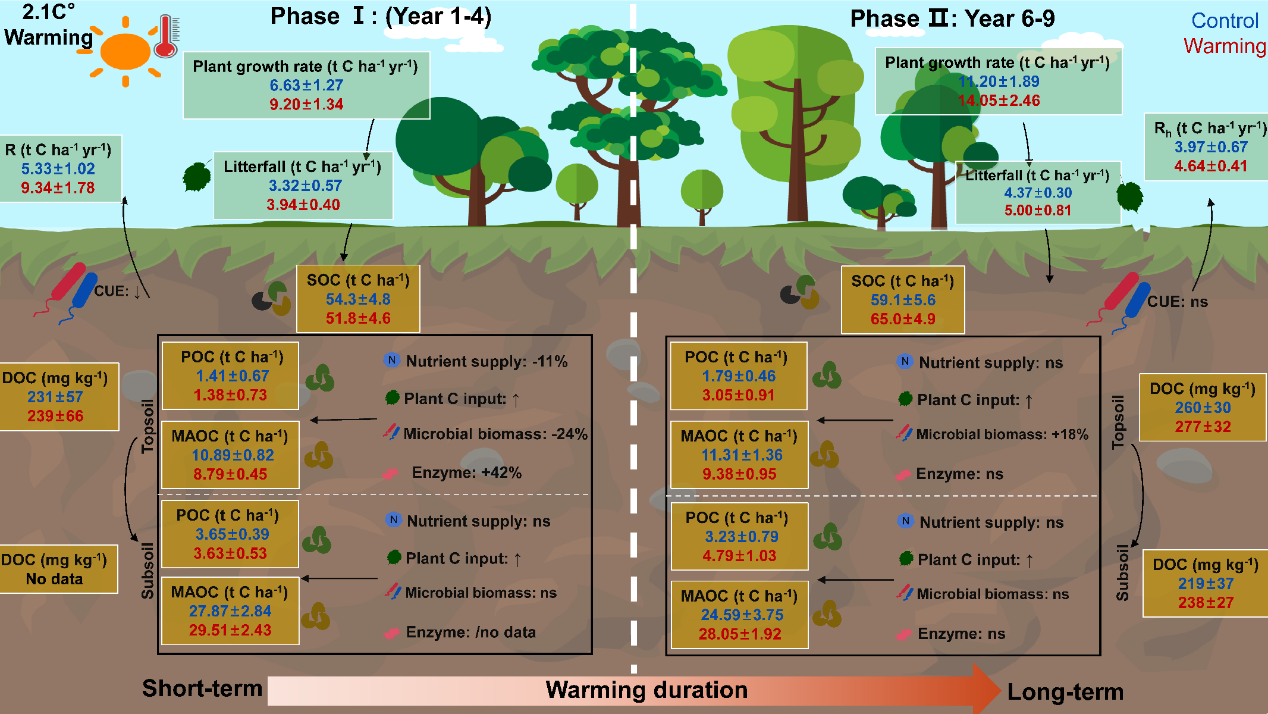Subtropical Forests Soils May Continue to Store Carbon Under Moderate Warming
A long-term field experiment has revealed that humid subtropical forests may continue to accumulate soil carbon under moderate warming, challenging the long-held assumption that global warming inevitably turns these ecosystems into carbon sources. This finding has been published in One Earth on October 6, 2025.
Led by Prof. LIU Juxiu from the South China Botanical Garden, Chinese Academy of Sciences, researchers conducted a nine-year ecosystem-level passive warming experiment in a humid subtropical forest using an elevational translocation approach that simulated realistic warming of up to +2.1°C.
The study found that soil organic carbon exhibited a two-phase response to warming: initial loss (years 1–4) due to reduced topsoil mineral-associated organic carbon, followed by accumulation (years 6–9) attributed to sustained plant carbon inputs and microbial adaptation that increased particulate organic carbon.
“Our results show that moderate warming does not necessarily lead to soil carbon loss. Sustained plant carbon inputs and microbial thermal adjustments can help maintain—or even enhance—soil carbon storage in some humid subtropical forests,” said Dr. LIU Xujun, first author of the study.
“This is encouraging, as projections often assume that warming will weaken—or even reverse—the carbon sink capacity of tropical and subtropical forests, potentially leading to overly pessimistic assessments of forest-based climate mitigation in these regions. However, This findings provide a more optimistic outlook, suggesting that under modest warming, afforestation in some relatively cool and humid subtropical mountainous areas suitable for forest growth could potentially help enhance soil sequestration of atmospheric carbon,” said Prof. Liu.
The researchers further discovered that warming-induced plant–microbe nutrient competition accelerated mineral-associated organic carbon loss. “This underscores the need to place greater emphasis on plant–soil interactions when regulating forest soil carbon dynamics in Earth system models and forest management, as they not only mediate the fate of soil carbon stocks but also influence the accumulation patterns of different soil carbon fractions,” Prof. LIU said. “For example, afforestation and forest restoration efforts should avoid excessive use of tree species with inefficient nutrient utilization—particularly of limiting nutrients—or species whose rapid growth may outpace soil nutrient supply.”
Overall, the study provides new insights into how plant–soil interactions mediate long-term soil carbon balance in subtropical forest ecosystems and offers an optimistic perspective for forest-based climate mitigation. Paper link: https://doi.org/10.1016/j.oneear.2025.101465

Figure . Conceptual diagram of the effect of ecosystem-level warming on soil organic carbon and its’ fractions in a seasonal subtropical forest. (image by LIU et al)
File Download: